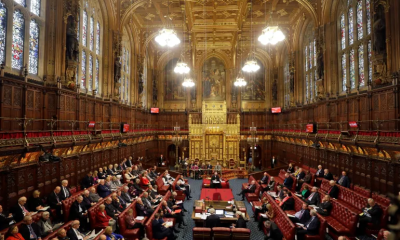Foreign News
Rishi Sunak faces crunch Rwanda vote as Tory MPs split

Prime Minister Rishi Sunak is facing a battle to persuade Tory MPs to back his flagship Rwanda bill, ahead of a key vote today (12).
The legislation seeks to revive the government’s plan to send some asylum seekers to the east African country.MPs on the right of the party have said the bill does not go far enough and will not work in its current form. But more centrist MPs warned against any changes which would breach international law.
Former Defence Secretary Ben Wallace urged his fellow Tory MPs not to “wreck” the government by voting down the bill. He warned against “making the perfect (but unrealistic) the enemy of the good”.
The Safety of Rwanda Bill faces its first Parliamentary test – known as its second reading – on Tuesday, when MPs get a chance to debate and vote on the main principles of the bill.
The aim of the policy is to deter migrants from crossing the Channel and it is central to the government’s plan to “stop the boats” – which Mr Sunak has made one of his key priorities.
A rebellion by Tory MPs could sink the Rwanda scheme and severely damage the prime minister’s authority.
Among those on the right of the party, the New Conservatives group said the bill required “major surgery or replacement”. More than 40 members met on Monday evening to discuss how they would vote. Several MPs leaving the meeting said they were deciding between abstaining or voting against the bill.Two MPs said the group had the numbers to vote the legislation down and that only one or two in meeting had spoken in support of voting for the bill. Members of the group are due to meet Mr Sunak on this morning.
Earlier, the European Research Group – an influential group of Tory MPs also on the right of the party – said the bill provided an “incomplete solution” to the problem of legal challenges that could be mounted against individuals being sent to Rwanda. It said “very significant amendments” would be needed.
The group has not yet decided how to vote on Tuesday. Its chairman Mark Francois called on the government to pull the bill and come up with a revised version without “so many holes in it”.
However, agreeing to the demands of MPs on the right of the party would risk losing the support of more centrist Tories.
Following a meeting on Monday evening, the centrist One Nation group of Conservative MPs, which includes more than 100 MPs, said it was recommending its members vote for the bill at this stage. But the group said it would oppose any future amendments to the bill “that would mean the UK government breaching the rule of law and its international obligations”.
The group’s chairman, former Deputy Prime Minister Damian Green, urged the government to “stand firm against any attempt to amend the bill in a way that would make it unacceptable to those who believe that support for the rule of law is a basic Conservative principle”.
It is very rare for a bill to be defeated at its first Commons hurdle and this has not happened since 1986.
However, Labour and opposition parties have already said they will try and vote it down, meaning the government needs to ensure enough Tory MPs vote for it to allow it to pass.
Tory critics of the bill could decide to allow it to pass at this stage, possibly by abstaining, in the hope of securing concessions from the government as it goes through the Commons.
But some MPs who previously appeared inclined to back the government in Tuesday’s vote, in the hope of amending the bill at a later stage, now seem much more pessimistic about that possibility. “There’s no way we’d have the votes to amend it next year,” one Tory MP told the BBC. “It’s now or never.”
If there are enough rebels to inflict a defeat this would be near-apocalyptic for Mr Sunak in political terms. That prospect may be enough for him to withdraw the bill completely.
Going ahead with the vote and being defeated would potentially presage a leadership election, perhaps even a general election. Those around the PM acknowledge the numbers are tight but say they are confident they can win and insist they are not going to pull the vote.
The government introduced the emergency legislation last week, after the Rwanda policy was ruled unlawful by the Supreme Court.
The bill seeks to stop flights being blocked on legal grounds, by declaring in UK law that Rwanda is a safe country.
Those who want it to go further argue it is still open to legal challenge by individuals, if they can provide compelling evidence their personal circumstances mean they would be at risk of serious harm if they were removed to Rwanda.
In an attempt to win over critics, the government took the unusual step of publishing a summary of its own legal advice on the scheme.
The document says the bill allows for “an exceptionally narrow route to individual challenge” – but that to block all court challenges “would be a breach of international law”.It gives examples such as people in the late stages of pregnancy who are unfit to fly or with very rare medical conditions that could not be cared for in Rwanda.
However, critics argue that even if only some of these claims succeed, they would still clog up the courts and delay removals.
Downing Street said the government would continue to listen to the views of MPs but it believed the bill was “strong enough to achieve its aims”.
(BBC)
Foreign News
Nasa ‘Earthrise’ astronaut dies at 90 in plane crash

Apollo 8 astronaut Bill Anders, who snapped one of the most famous photographs taken in outer space, has died at the age of 90.
Officials say a small plane he was flying crashed into the water north of Seattle, Washington.
Anders’ son Greg confirmed that his father was flying the small plane, and that his body was recovered on Friday afternoon. “The family is devastated. He was a great pilot. He will be missed,” a statement from the family reads.
Anders – who was a lunar module pilot on the Apollo 8 mission – took the iconic Earthrise photograph, one of the most memorable and inspirational images of Earth from space.
Taken on Christmas Eve during the 1968 mission, the first crewed space flight to leave Earth and reach the Moon, the picture shows the planet rising above the horizon from the barren lunar surface.
Anders later described it as his most significant contribution to the space programme.

The image is widely credited with motivating the global environmental movement and leading to the creation of Earth Day, an annual event to promote activism and awareness of caring for the planet.
Speaking of the moment, Anders said: “We came all this way to explore the Moon, and the most important thing that we discovered was the Earth.”
Officials said on Friday that Anders crashed his plane around 11:40PDT (1940BST).
The US National Transportation Safety Board (NTSB) said the 90-year-old was flying a Beechcraft A A 45 – also known as a T-34. The agency said that the plane crashed about 80ft (25m) from the coast of Jones Island.
Anders also served as the backup pilot to the Apollo 11 mission, the name of the effort that led to the first Moon landing on July 24, 1969.
Following Anders’ retirement from the space programme in 1969, the former astronaut largely worked in the aerospace industry for several decades. He also served as US Ambassador to Norway for a year in the 1970s.
But he is best remembered for the Apollo 8 mission and the iconic photograph he took from space.
“In 1968, during Apollo 8, Bill Anders offered to humanity among the deepest of gifts an astronaut can give. He traveled to the threshold of the Moon and helped all of us see something else: ourselves,” Nasa Administrator Bill Nelson said in a statement.
Mark Kelly, a former astronaut who now serves as a US Senator for the state of Arizona, said in a post on X, formerly Twitter, that Anders “inspired me and generations of astronauts and explorers. My thoughts are with his family and friends”.
[BBC]
Foreign News
China’s Chang’e-6 lifts off from far side of Moon with rock samples

A Chinese spacecraft carrying rock and soil samples from the far side of the Moon has lifted off from the lunar surface to start its journey back to Earth, according to state media.
The achievement on Tuesday is a world first and the latest leap for Beijing’s decades-old space programme, which aims to send a crewed mission to the Moon by 2030.
The Xinhua News Agency, citing the China National Space Administration (CNSA), said that the ascender of the Chang’e-6 probe took off at 7:38am local time on Tuesday (23:38 GMT) and entered a preset orbit around the moon.
It described the move as “an unprecedented feat in human lunar exploration history”.
The Chang’e-6 probe was launched last month and its lander touched down on the far side of the Moon on Sunday. It used a drill and robotic arm to dig up soil on and below the Moon’s surface, according to Xinhua.
After successfully gathering its samples, the Chang’e-6 unfurled China’s national flag for the first time on the far side of the Moon, it said.
The agency cited the CNSA as saying that the spacecraft stowed the samples it had gathered in a container inside the ascender of the probe as planned.
[Aljazeera]
Foreign News
China says its spacecraft lands on Moon’s far side

China says its uncrewed craft has successfully landed on the far side of the Moon – an unexplored place almost no-one tries to go.
The Chang’e 6 touched down in the South Pole-Aitken Basin at 06:23 Beijing time on Sunday morning (22:23 GMT Saturday), the China National Space Administration (CNSA) said.
Launched on 3 May, the mission aims to collect precious rock and soil from this region for the first time in history. The probe could extract some of the Moon’s oldest rocks from a huge crater on its South Pole.
The landing was fraught with risks, because it is very difficult to communicate with spacecraft once they reach the far side of the Moon. China is the only country to have achieved the feat before, landing its Chang’e-4 in 2019.
After launching from Wenchang Space Launch Center, the Chang’e 6 spacecraft had been orbiting the Moon waiting to land. The lander component of the mission then separated from the orbiter to touch down on the side of the Moon that faces permanently away from Earth.
During the descent, an autonomous visual obstacle avoidance system was used to automatically detect obstacles, with a visible light camera selecting a comparatively safe landing area based on the brightness and darkness of the lunar surface, the CNSA was quoted as saying by state-run Xinhua news agency.
The lander hovered about 100m (328ft) above the safe landing area, and used a laser 3D scanner before a slow vertical descent. The operation was supported by the Queqiao-2 relay satellite, the CNSA said.
Chinese state media described the successful landing as an “historic moment”. The state broadcaster said “applause erupted at the Beijing Aerospace Flight Control Center” when the Chang’e landing craft touched down on the Moon early on Sunday morning.
The lander should spend up to three days gathering materials from the surface in an operation the CNSA said would involve “many engineering innovations, high risks and great difficulty”. “Everyone is very excited that we might get a look at these rocks no-one has ever seen before,” explains Professor John Pernet-Fisher, who specialises in lunar geology at the University of Manchester.
He has analysed other lunar rock brought back on the American Apollo mission and previous Chinese missions. But he says the chance to analyse rock from a completely different area of the Moon could answer fundamental questions about how planets form.
Most of the rocks collected so far are volcanic, similar to what we might find in Iceland or Hawaii. But the material on the far side would have a different chemistry . “It would help us answer those really big questions, like how are planets formed, why do crusts form, what is the origin of water in the solar system?” the professor says.
The mission aims to collect about 2kg (4.4lb) of material using a drill and mechanical arm, according to the CNSA.
The South Pole–Aitken basin, an impact crater, is one of the largest known in the solar system.
From there, the probe could gather material that came from deep inside the lunar mantle – the inner core of the Moon – Prof Pernet-Fisher says.
The Moon’s South Pole is the next frontier in lunar missions – countries are keen to understand the region because there is a good chance it has ice.

The capsule in the last Chinese moon mission, Chang’e 5, brought back soil and rocks in 2020 (BBC)
Access to water would significantly boost the chances of successfully establishing a human base on the Moon for scientific research.
If the mission succeeds, the craft will return to Earth with the precious samples on board a special return capsule.
The material will be kept in special conditions to try to keep it as pristine as possible.
Scientists in China will be given the first chance to analyse the rocks, and later researchers around the world will be able to apply for the opportunity too.
This is the second time China has launched a mission to collect samples from the Moon.
In 2020 Chang’e 5 brought back 1.7kg of material from an area called Oceanus Procellarum on the Moon’s near side.
China is planning three more uncrewed missions this decade as it looks for water on the Moon and investigates setting up a permanent base there.
Beijing’s broader strategy aims to see a Chinese astronaut walk on the moon by around 2030.
The US also aims to put astronauts back on the moon, with Nasa aiming to launch its Artemis 3 mission in 2026.
(BBC)






















